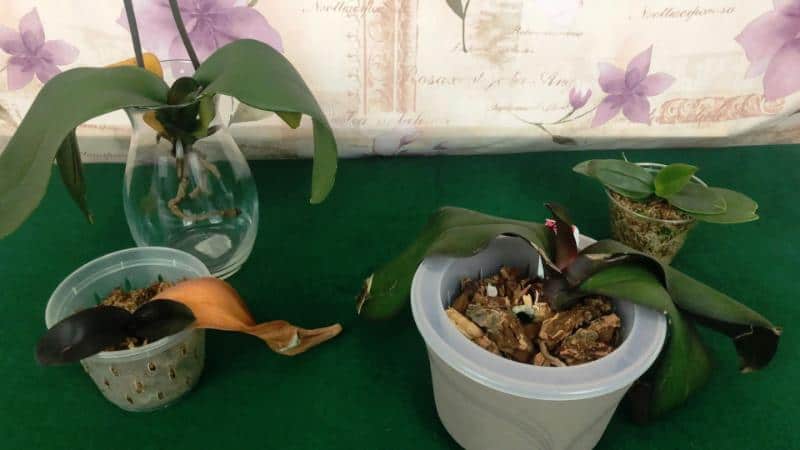If you’re an orchid lover, then you know that the best way to care for them is with proper watering. However, if your orchids are starting to look droopy and wilted, it’s likely because they’ve been underwatered. This blog post will show you how to revive an underwatered orchid so that it looks healthy again.
How To Spot a Dehydrated Orchid
There are many things to consider when you want to take care of your orchids. One important thing is whether or not the plant is getting enough water. If it doesn’t have enough water, it will become dehydrated and it will slowly start dying. Below we will go over how to spot a dehydrated orchid and what you can do about it.
Orchid Leaves Wrinkled and Limp
The number one way to spot a dehydrated orchid is by its leaves. When an orchid is thirsty, its leaves will start to wrinkle and droop.
That’s why it’s a good idea to keep an eye out for the signs of dehydration by observing your orchid’s leaves so you can be sure you’re giving them enough water.
Orchid Potting Mix is Dry
Another way to check if your orchid is underwatered is to feel the potting mix. If it feels dry and dusty, or crumbly, chances are your plant needs watering.
You can also tell if your plant isn’t getting enough water if little salt crystals start to form at the surface of the potting mix.
Orchid Aerial Roots Drying Out
If the aerial roots on your orchid are drying out and starting to turn brown, there is a good chance your orchid has been underwatered. At this point, you will have to take extra steps to maintain its water needs. This includes misting more often or making sure your potting soil doesn’t dry out completely in between watering.
Brown Leaves
Another sign to look for is if the leaves turn brown and crispy at their edges. This typically means that they’re starved for moisture. If this goes on too long, the affected leaves will slowly start to turn brown/black and eventually fall off.
Orchid Signs of Underwatering
- Wrinkled orchid leaves
- Orchid leaves curling
- Orchid aerial roots drying out
- Orchid roots dry shriveled
- Dead orchid roots
- Orchid flowers wilting
How To Water Orchids
Orchids are one of the most popular plants to grow indoors. They are easy to care for, but they do need a little bit of extra attention when it comes to watering. Below we’ll go over how to water an orchid so you can avoid the problems associated with underwatering an orchid.
Soak Roots

To water orchids, put water in a bowl and dip the plant’s pots so that the potting media is partially submerged for a few minutes.
Make sure you don’t allow any water to cover the fragile crown or leaves of the plant.
Once this is done, let it drain completely. This will keep your orchid healthy and also help reduce the risk of root rot.
Spray/Mist

Mist your orchids with water using a spray bottle. This will supply them with the right amount of water they need to maintain an ample level of humidity for their leaves. Never excessively wet them, as too much moisture can encourage fungal diseases.
Ice

Some orchid growers recommend watering an orchid with ice. We don’t like using ice cubes since they can damage the leaves and roots of an orchid. This makes sense, as the cold temperature will damage the plant’s tissues and roots, causing it to suffer stress and potentially lose water.
If you need to give your orchid a nice drink because the soil has completely dried out, it would be better to use lukewarm water instead.
How often should I water my orchid?

The watering needs of an orchid vary depending on the size of the pot, plant, and environmental conditions. However, in general, most orchids need to be watered once a week to thrive.
Some people may feel nervous about watering their orchids, but watering an orchid is easy. All you have to do is water every week.
You can also water a little more often if the potting mix starts to dry out before it’s time for your next weekly watering.
In addition, if your orchids need a little pick me up in between watering you can mist your orchids with room-temperature filtered water to keep them properly hydrated until their next soak.
Tip: If you are away from home often, or if you frequently forget to water your orchids you might want to look into getting an Automatic Watering System for Indoor Plants
Should I use tap water on my plant?

Certainly, most orchids will be happy with water straight from the tap, but orchids do best when you give them “RO” or reverse osmosis water that has been remineralized following the Michigan State University orchid fertilizer formula.
Do You Water Orchids From the Top or Bottom
You can water orchids from the top of the pot, but watering orchids this way might lead to uneven moisture distribution in the potting media.
The best way to water an orchid is to dip the bottom of the flowerpot into a bowl with some water. Sit the orchid in the water for at least 30 seconds then gently pick it up and let it drain fully. This method of watering is called ‘bottom-dipping’.
How to water orchids in bark

To water orchids in bark, soaking the pot is ideal. Bark takes a while to absorb moisture. The best way to tell if your plant needs water or not is that it should be light when you pick it up. If it’s heavy, then it probably doesn’t need water.
How to water orchids in moss

Since moss is highly absorbent, you don’t want to overwater it because that can cause disease. That means misting should be enough for orchids growing in moss. Or, lightly hand watering once or twice a week is just fine too. As long as the moss stays moist but not soaked all week then your orchid should be happy
What type of potting mix is best for an orchid?

rePotme Orchid Potting Mix (Buy Online) is a high-quality potting mix that provides the perfect environment for orchid roots. We’ve found it to be an excellent choice because it offers the right balance of aeration and moisture retention.
Why is My Orchid Dying
Being Underwatered, Overwatered, lacking nutrients, or poor lighting conditions are all possible reasons your orchid might be dying.
Underwatered
If an orchid plant has not been watered for more than a week or two, this can cause an orchid to slowly start dying.
Overwatered
Overwatering can lead to root rot which will degrade your plant’s roots and delicate crown. Excess water will also carry nutrients away from your plants, which can cause nutrient deficiencies to crop up.
Lack of Nutrients
If an orchid is not getting enough nutrients it will start to die. For instance, if the potting medium becomes too dry, the roots will slow their absorption of nutrients.
Additionally, the plant’s other requirements for nutrients – nitrogen (N), phosphorus (P), and potassium (K) might not be met due to either poor root health or incorrect fertilization practices.
Poor Lighting Conditions
Lighting should be bright but filtered through a sheer curtain or shade cloth; since direct sunlight damages orchid leaves and flowers alike.
Temperature & Humidity
You might want to look into other things like temperature shifts, low humidity, and cold drafts since these factors can also cause an orchid to die.
Pests
Pests could also be attacking your prized orchids. For additional help controlling aphids, fungus gnats, and spider mites you can read the following articles.
How To Revive an Orchid
How do you revive an orchid? Orchids are beautiful plants, but sometimes they need a little help. It is important to know how to revive your orchid for it to live up to its full potential.
First, water your orchid with room temperature water and allow the excess water to drain out of the pot.
Next, place the plant in indirect sunlight while keeping them moist by watering them every week.
Finally, fertilize once a month using a specially formulated orchid fertilizer.
This will ensure that you have a happy healthy orchid that leads a long healthy life.








